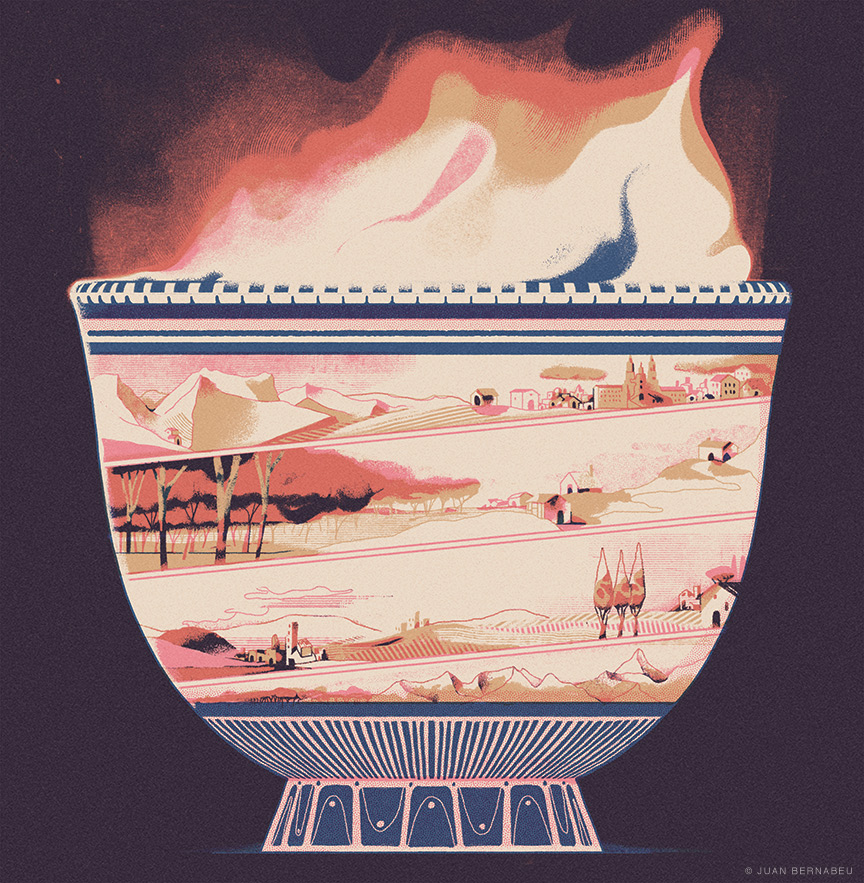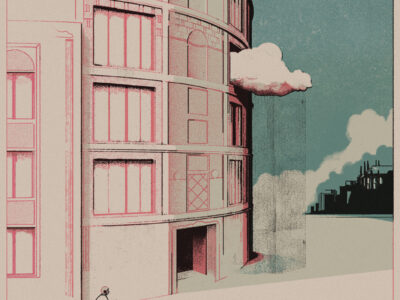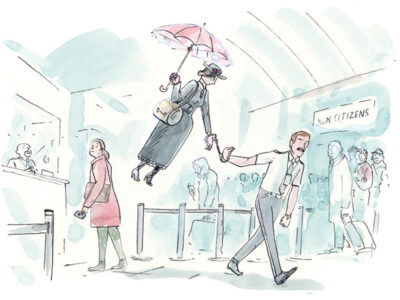
Pilgrimage and purification.
By Beebe Bahrami
A woman at the neighboring table stood, lifted her coffee spoon from its saucer, and walked to the bar. Though it was not yet seven in the morning, she wore a tailored beige wool skirt and jacket over an ivory silk blouse, its scarf tie knotted in a perfect flouncy bow. Her hair, like that of her equally elegant friend, had been salon-styled and frosted after the season’s fashion among women in their seventies. By contrast, I had barely managed to tuck in my T-shirt and zip up my rain jacket. I watched as she pushed her spoon toward the bartender.
“Hit me up,” she said, “I don’t want to go to the doctor.”
Without skipping a beat, the bartender grabbed a clear liquid bottle and tipped a splash of orujo into her spoon. She downed it and held her spoon out again. “Uno más.” The bartender obliged. The woman gulped it, thanked him, and returned to her friend.
“I already feel better,” she said, and sat.
Orujo, the local eau de vie, is fermented and distilled from the pressed skins, stems, and seeds left over from winemaking, much like Italian grappa and French marc. I was in northwest Spain, passing through Ponferrada—a city on the Camino de Santiago pilgrimage route famed for its towering Templar castle and its position at the heart of the Bierzo wine region. I had reached it on foot, through a valley striped with grape vines surrounded by mountains on all sides.
I’d dipped into this café for a quick breakfast before hitting the trail once more, another day in more than a month of walking and research that had begun on the French side of the Pyrenees. I loved this route, so much so that I returned almost annually to delve more deeply into the lands it crossed and connected. There was always another historic, folkloric, archaeological, or cultural layer beneath the ones I’d previously trained my anthropological attention on. But the Camino to me was more than an intellectual fascination. It was a way to hit a reset button on my life, offering fresh perspectives that seemed easier to absorb when I reduced my life needs to what I could carry in a backpack, ditched my routines, and relied on my feet and sense of direction to move across hundreds of miles. In more than one way, I’d been here before. But this was the first time I had seen anyone down orujo so early in the morning. I’d first encountered the 80-proof liquid two decades earlier in a Galician village on the Atlantic coast where a chef cheered by my enjoyment of his cooking gave me a complimentary shot of an herb-infused version as an after-dinner drink. People all across northern Spain, I learned, revered it as a digestion aid and a health tonic.
Tired and worn and tempted after weeks of walking, I looked at the café’s clock and thought better of following the woman’s example. I paid my bill, hoisted my pack, and returned to the trail. I was likely to find more orujo ahead, and with better timing. Practically everyone still made their own, in homes and bars alike. What I really wanted was to imbibe it in its full-blown Galician purifying and cleansing ritual, queimada, a Camino ritual I had yet to experience.
Queimada is a Galician word related to the Spanish verb quemar, to burn. It’s a tradition that may go back to the Middle Ages, or even earlier, that burns off bad energy and evil spirits. Long a part of festivals and large family gatherings in León and Galicia, it has lately gained popularity among pilgrims crossing these regions on their way to Santiago de Compostela. But it’s never planned; it is offered as a spontaneous gift, given when the mood strikes among local hosts in pilgrim lodgings and cafés.
From Ponferrada I crossed a fertile valley of vines and orchards before climbing the final mountains that stood between me and Santiago. Along that 155-kilometer crossing I passed several pilgrims’ hostels famed for their queimada, but at each one the spell-maker was either absent or not feeling the mood. I arrived in Santiago de Compostela unburned.
Exhausted but elated after seven weeks on the trail, I dove into the rituals of arrival, most importantly visiting the cathedral and hugging the statue of Saint James the Greater on the altar, delivering the prayers and blessings of all the people who along the way had wished me buen Camino and asked me to carry their hopes to Santiago with mine. By the time I finished, night had fallen and a cold rain pelted the cobblestones and arched passageways of the medieval town.
Having arrived at my pilgrim’s goal, my walking had no sense of direction. I wandered the streets aimlessly, content but also sad that this adventure had ended, wondering if this walk had changed me.
The rain intensified. The temperature dropped. I ran and ducked into a porticoed passageway where a large picture window looked into a candlelit Belle Epoque café filled with cozy overstuffed lounge chairs. I entered and was soon installed in one, wrapped in companionable conversation from surrounding tables.
All that suddenly stopped. I followed others’ eyes to a waiter emerging from the kitchen with a large clay bowl fitted with a clay lid. He set it on a low central table next to an array of espresso-sized clay cups and a clay ladle. A colleague then draped a hooded medieval-style cape over the man’s shoulders and handed him a large walking staff. All remained quiet as he removed the bowl’s lid, set it aside, and began a slow chant as he took up a bottle of orujo and decanted it into the pot.
As he continued the spell and lit the surface with a torch, I heard the words, “owls, toads, and witches…”
Throwing in lemon and orange peels, coffee beans, and sugar, stirring it all with the ladle, he called upon “the earth, air, water, and fire” to give power and grace to this act of purification and restored balance. And as the bowl became more and more a clay cauldron afire with red-blue flames rising several feet above the rim, he beckoned good spirits to join us and help us dispel all that was negative and unwanted.
The flame surged, the room was still, the spellcaster silent, the air electrified with zest, coffee, and firewater fumes. I inhaled. In that fragrant lungful I felt the fatigue, sadness, and uncertainty begin to fall away as joy rose in their place. The cloaked man then put out the flame with the clay lid and ladled the elixir into cups, handing me one with a luminous smile—more druid than waiter.
I cupped the warm drink and cautiously sipped. It was unexpectedly light, and complex with its mingled zests and coffee. More surprising was how that first sip began to melt away any outdated thoughts and replaced them with insights from the long trek. Five-hundred miles of carrying only what I needed had built muscle and dropped useless ideas—like worrying too much about what others thought, or revisiting old regrets over things said and unsaid. Life was not perfect and neither had this walk been; plans had come undone and been replaced. I had met so many people and received so much kindness. I thought of the Riojan family who shared figs from their garden, the Castilian grandmother who offered fresh water and her life story, the Galician mother who hugged me and called me brave, confessing her dream to walk this walk, too. I thought of crossing the Pyrenees with the American soldier walking for healing, the North Carolinian family who had lost everything in a fire walking in gratitude for each other, the young Korean looking to test herself outside of social expectations, the Swedish couple striving to heal their marriage, the Coloradan walking in gratitude after battling cancer, and the many conversations over communal pilgrim dinners talking about life’s mysteries, never once asking each other what we did for a living. I thought of the three mountain ranges, the open plains, the valleys and rivers I had crossed. How could one walk this and not be changed? I wondered how those changes would reveal themselves as I returned home.
All this passed in that first sip. I took a second and understood that the Camino’s transformative magic operated on a simple principle: it gave each person what she or he needed most, in perfect timing, when least expected. What it asked in return was that you trusted the process, and walked freely into the unknown.
Beebe Bahrami Gr’95 is the author of The Way of the Wild Goose—Three Pilgrimages Following Geese, Stars, and Hunches on the Camino de Santiago (Monkfish Book Publishing) and Moon Camino de Santiago (Hachette).




